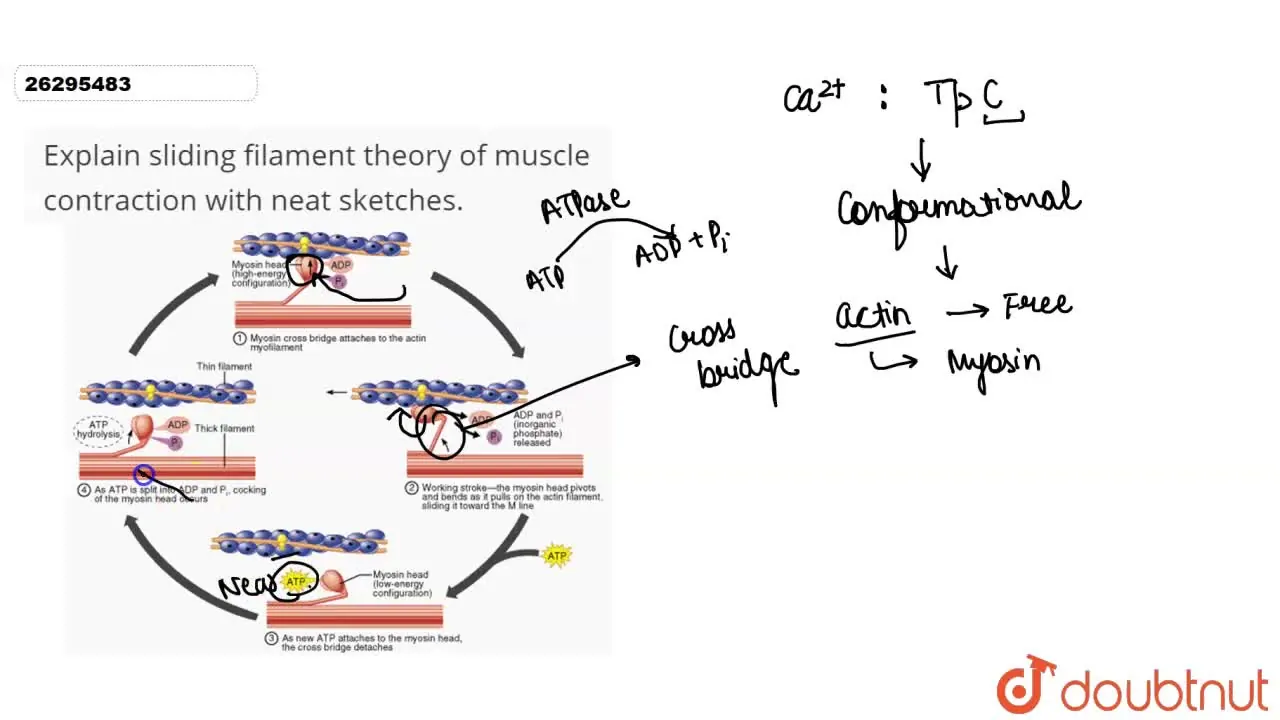Explain sliding filament theory of muscle contraction with neat sketches.
Sliding filament theory
This theory is applicable to smooth, cardiac and skeletal muscles. The essential features of this theory are as follows
(i) During muscle contraction contraction, thin myofilaments slide inward towards the H-zone.
(ii) The sarcomere, the basic unit of muscle contraction, shortens, without changing the length of thin and thick myofilaments.
(iii) The cross-bridge of the thick myofilaments connect with the portions of actin of the thin myofilaments. These cross-bridge move on the thin myofilaments, resulting in the sliding of thin and thick myofilaments over each other.
(iv) The length of the thick and thin myofilaments do not change during muscle contraction.
(v) A muscle fibre maintains a resting potential undre resting conditions just like a nerve fibre. As soon as a nerve impulse reaches the terminal end of the axon, small sacs called synaptic vesicles fuse with the axon membrane and release a chemical transmitter, called acetycholine.
It diffuses across the synaptic cleft (the space between the axon membrane and the motor end plate ) and binds to the receptor sites of the motor end plategt
(vi) As soon as depolarisation of the motor end plate reaches a certain livel, it creates an action potential. After this, an enzyme cholinesterase present along with the receptor sites for acetylcholine breaks down acetylcholine into acetete and choline.
A portion of the choline diffuses back to the axon and is reused to synthesise more acetylcholine for the transmission of subsequent impulses.
(vii) Calcium plays a key regulatory role in muscle contraction. The Ca2+ inos bind to troponin causing a change in its shape and position. This in turn alters the shape and position of tropomyosin.
This shift exposes the active sites on the F-actin molecules and myosin cross-bridges are then able to bind to these active sites.
(viii) The head of each myosin molecule contains an enzyme myosin ATPase. In the presence of myosin ATPase, Ca2+andMg2+ inos, ATP breaks down into ADP and inorganic phosphate as
ATPMyosin ATPase−−−−−−−−→Ca2+,Mg2+ADP+Pi+Energy

(ix) Energy from ATP causes energised myosin cross-bridges to bind to actin. The energised cross-bridge move, causing the thin myofilaments to slide along the thick myofilaments. This movement is like the movements of the oars of a boat.
(x) As staed earlier in theory, there is no shortening of thin and thick myofilaments. However, the sarcomere shortens, because of the sliding of the thin myofilaments produced by cross-bridge movements. The H-zone and I-band shorten, but the width of the A-band remains constant.
Related Playlists
- BOOK - NCERT EXEMPLARCHAPTER - LOCOMOTION AND MOVEMENTEXERCISE - Short Answer Type Questions9videos
LOCOMOTION AND MOVEMENT
- BOOK - NCERT EXEMPLARCHAPTER - EXCRETORY PRODUCTS AND THEIR ELIMINATION EXERCISE - Long Answer Type Questions6videos
EXCRETORY PRODUCTS AND THEIR ELIMINATION
- BOOK - NCERT EXEMPLARCHAPTER - MINERAL NUTRITIONEXERCISE - Long Answer Type Questions8videos
MINERAL NUTRITION
Similar Questions
Define sliding filament theory of muscle contraction.
View SolutionSliding filament theory of muscle contraction was given by
View SolutionDuring muscle contraction
View SolutionDuring muscle contraction
View SolutionDuring muscle contraction
View SolutionDuring muscle contraction
View SolutionDuring muscle contraction
View SolutionAccording to sliding filament theory of muscle contraction, the filament that move to shorten a muscle are
View SolutionRead the following statements is context to muscle tissue and choose the correct answer .
(i) Excessive exercise results in anaerobic Respiration and forms lactic acid .
(ii) As per sliding filament theory of muscle contraction, the filament that moves to shorten a muscule is actin .
(iii) The muscles primarily involved in locomotion is striated muscles .View SolutionBasic unit of muscle contraction is
View Solution


